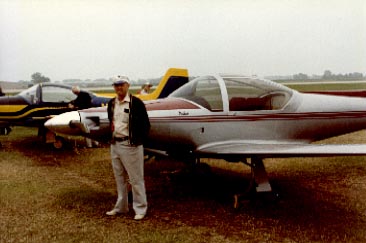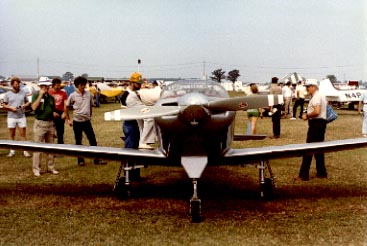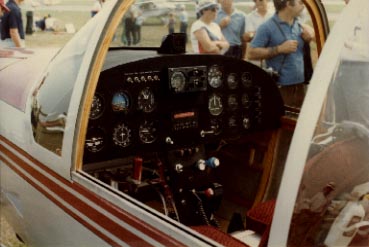Larry Wohlers' Falco
![]()
Larry Wohlers' Falco |
|
by Jack Cox
|
This article appeared in the February 1983 issue of Sport Aviation. |
Alfred Scott, Virginia real estate developer, folk music recording artist and aviation entrepreneur, was very likely the most surprised person around when he learned Tucson's Larry Wohlers had flown the first homebuilt Falco of June 14 of last year.
"How could he have possibly flown," Alfred exclaimed, "I haven't finished redrawing the plans yet!"*
Larry, who has a fine sense of humor, says, "Hey, I'm 73 years old... I couldn't fool around waiting for Alfred to finish the plans!""
The first flight of any homebuilt in the culmination of all sorts of activity and effort on the part of a number of people... and this is particularly the case with the Falco. For the benefit of those of you who have joined EAA within the last year of two, a little background information is necessary for you to fully comprehend the enormity of Larry Wohlers' effort. As you will learn, being first with the Falco was very much a case of successfully completing a "mission impossible".
For all its modern looks, the Falco is a 27 year old design. Its creator is an Italian mechanical/aeronautical engineer named Stelio Frati. Now 63, Frati is virtually a cult figure in Europe, with a following as fanatic as those for the geniuses of automotive design and entrepreneurship -- Ettore Bugatti, Ferdinand Porsche and others of their ilk. Frati made his name as the creator of beautiful and very fast airplanes... and it has become almost a cliche to position his efforts with the aviation on the same level as Ferrari's within the world of automobiles.
Since 1950, Frati has designed a succession of high performance, low winged machines, all of which bear the unmistakable Frati look-long, flowing fuselages with bubble canopies or cabins set low into them, but sensuous wing fillets and a vertical tail profile that is elegantly simple, yet as distinctive as one's signature... in this case Frati's. And don't look for flat sides, bottoms or, indeed, a flat anything on one of his airplanes. There are no aerodynamic compromises for the sake of manufacturing ease and economy. From any angle, you see nothing but compound, wind cheating curves.

Among Americans, only the cognoscenti were aware of the Frati designs until the SIAI Marchetti 260 began being imported here in the late 1960s as the Waco Meteor. This all metal, swept tail, high performance beauty that excited us so was a direct evolution of the Falco, a two-place, all wood, "straight tailed" job which initially flew on June 15, 1955. Many consider the Falco the most aesthetically "pure" airplane ever designed and built, and consider it Frati's crowning achievement. The aircraft he has subsequently designed, they believe, are natural progressions beyond the Falco... the four place Nibbio (Kite Hawk), the three seat Picchio (Woodpecker), the SF.260 and its many variants, the Delphino and others.
Until 1970 Frati worked as an independent aircraft designer, creating his works of aeronautical art and selling them to whomever he could find who was willing to produce them. In 1970 Frati formed a company, General Avia, which is a sort of design studio with facilities to build his own prototypes. Throughout, when Frati found a buyer of his design rights, they were produced in what would be considered sort of "cottage industry" here in the U.S. For example, a total of 110* Falco-in four series-were built by four different companies as follows:
Series I (Lycoming 0-290-D2B, fixed prop) -- 10 examples built by Aviamilano.
Series II (Lycoming 0-320, fixed prop) -- 20* examples built by Aviamilano.
Series III (Lycoming 0-320, fixed prop) -- 60 examples built by Aeromere.
Series IV (Lycoming 0-320-B3B, 160 hp, CS prop)-20 examples built by Laverda.
All were built in small shops on just a few sets of jigs and fixtures by a handful of craftsmen... handbuilt for all intents and purposes. The tempation is to characterize the process as uniquely European and compare it to the many small sports car and race car makers who operate on a similar scale, but that wouldn't be an accurate observation. We've seen a lot of that same sort of thing here in the U.S.-particularly in the 20s and 30s. Certification was easily within the capability of a single individual in those days, if he could do his own test flying in addition to the engineering. Matty Laird's operation is a prime example-a small shop turning out certified but nevertheless custom made airplanes. In its early years, Howards were produced in the same manner... in Laird's old buildings, in fact.
Anyway... Frati moved on to new designes and ultimately, the Falco production ground to a halt. The airplane became collector's items almost overnight... albeit actively used ones. There is even a special racing class for them in Europe. Occasionally, one would be lost to an accident, hangar fire, etc., so that by the coming of the 70s about half of the 110* remained. The Falco's fate appeared to be one of slow attrition and ever increasing value as they became more and more scarce.
But, then, along comes Alfred Scott.
A southern gentleman of independent means and an already well developed appreciation for aeronautical exotica (he has owned one of the handful of Messerschmitt 209 Monsuns in the U.S.), Alfred had formed a company, Sequoia Aircraft Corporation of Richmond, VA, and had employed David Thurston to engineer a high performance sport plane, the Sequoia, for his to market as a homebuilt. Long an admirer of the Falco -- you can see some of its lines in the Sequoia -- he somehow got the idea of putting it back on the market as a homebuilt. He established contact with Stelio Frati, made a deal with him and on April 25, 1979 announced his intentions to the aviation world. The following year, he announced the availability of Falco kits.
As all you Falco builders are thinking to yourselves at this moment, there was... and is... a lot more to the story than the simple sequence of events we've recounted here. What Alfred got from Frati was a set of shop drawings that had been provided the various little companies that had built the Falcos... in Italian, of course. Before he could sell them to U.S. homebuilders, they had to be redrawn, translated into English and done in such a manner that they could be used by amateur builders to construct an airplane. Building instructions would have to be written and when he decided to produce kits, all the manufacturers of subassemblies of suppliers of materials had to be lined up and set to work.
It's a process that's still going on today. Alfred is a perfectionist and is a great admirer of Frank Christensen's modus operandi... need I say more? When he is through with his work, the Falco plans/kit package will be top drawer in every respect, but it takes time to accomplish something of that magnitude... time that at least one of his builders was not willing to wait out.
The plans package the first group of builders received enabled them to construct the basic structure of the airplane. Alfred assumed this would keep them busy for a period of time sufficient for him to draw up all the various systems, refinements and additions he wanted to make and get them out to everyone in advance of their need for them... and for most builders this has been the case.
And that brings us to Larry Wohlers.
Larry received his plans in September of 1979 and being retired, began work on the airplane immediately. He had his own shop out in the desert from Tuscon and a wealth of building experience, so little time was lost in getting organized, assembling tools, etc. -- things first time builders often spend months trying to master.
The 14 laminated fuselage frames were tackled first, after which the tail surfaces were built and, then, the ailerons.
Next came the wing spar... "which is a project!" Larry says. "It's not necessarily the hardest thing to build, but it takes a lot of equipment and a alot of jigging to get it done properly."

Jigging, in fact, is one of the major elements in building a Falco, Larry points out. Every fuselage frame is of a different size, so it is necessary to build 14 jigs to make 14 frames. At least when building wing rib jigs, there's some comfort in the knowledge that two parts will be made in each.
Larry used several brands of glue -- Weldwood and T-88 on the fuselage frames and Hughes FPL-16 on the main spar. He found the T-88 to be the easiest to use.
As in the case of every set of drawings ever done, there were errors. Alfred was very good about sending out corrections, Larry says, but he was progressing so rapidly that all too often he had already build the part. He had to do a number of things over. In some instances, the error was apparent when he began fitting things together, so he figured out for himself how to correct it... then sometime later would get the plans correction from Scott. It was frustrating at times, but Larry know he was in never-never land when he got ahead of the pace.
"I just made everything work," he says today.
Once the basic all-wood structure was complete, however, his problems really began. The canopy, engine mount, cowling, landing gear and a host of small items were not yet available. No one was supposed to be ready for those items so quickly! Undaunted as usual, Larry simply forged onward, making or farming out the missing stuff.
He had a lot of grief over the canopy. A preblown one didn't fit*, so he bit the bullet, made a mold and shipped it to Seattle where Gee Bee used it to make a very nice three-piece windshield and canopy set.
The lack of an engine mount, cowl, etc., was a problem that ultimately solved itself when Larry chose to use a Twin Comanche lash-up virtually from the firewall forward. There was a lot of work involved in making everything fit as it should, but at least all the goodies were there to work with.
The landing gear was the next hurdle. Larry built his from scratch, using stock oleos and off-the-shelf acme thread screws*. The nose gear was quite an engineering exercise. The factory Falco's nose gear retracts only partially, leaving a portion of the wheel exposed. Larry didn't care for that, so he modified a Tri Pacer nose gear... including making his own smaller fork... and made it retract completely into the fuselage. He also engineered and build a nose gear door, which other Falcos don't (and won't*) have. The Falco has a relatively thin wing and Frati selected a narrow wheel and tire so it would fit up in the wheel well. Larry made his by sectioning* stock wheels.
Now, remember, all this was well out in advance of Sequoia's plans and kits. By this time, Larry was completely on his own... in uncharted waters. It didn't slow him down a bit, however. He was determined to be the first homebuilt to complete a Falco and the first to fly one to Oshkosh. He could now see the light on the horizon, so it was hell for leather the rest of the way.
The finished airframe was covered with 1.7 oz. dacron and shot with 4 coats of Stits silver, over which a final finish of silver metallic Imron was applied. The maroon trim was his wife Edna's choice and was added sparingly and in good taste.
The complete airplane was moved to Ryan Field west of Tucson and there on June 14, 1982 the initial test flight was made... one day short of the 27th anniversary of the very first flight of a Falco. There were no major hitches and after 25 minutes, Larry rewarded those waiting patiently on the ground with an "I'm O.K." low pass before landing. It had taken 32 months of very hard, more or less full time work to complete the airplane... including a 10 week layoff to allow a broken leg to mend. One day he had fallen while working on the airplane and snapped a bone.
It was worth the effort.. and maybe even the pain... however. The Falco flew beautifully and was fast. He had chosen the design because of the speed claims made for it, and he wasn't to be disappointed. At a conservative cruise power setting of 20 inches and 2400 rpm, the airplane indicates 162/163 mph. At 22 inches and 2450, it will indicate 175. Larry's bird has a potential non-stop range of around 1100 miles. The Falco's standard fuel capacity is 31.5 gallons*, but his was increased to 45 gallons. He built it for comfortable, fast cross country flying and that is what the airplane does best, he says. The Falco is stressed for aerobatics, but because of the long Twin Comanche prop extension, he has placarded his airplane against doing flip-flops of any sort.
Building airplanes is nothing new for Larry Wohlers. In 1928, when he was just 19, he was in La Salle, Illinois, helping build three little cabin jobs called the La Salle Coupe. They were a lot like a Velie Monocoupe, he recalls, and one of them, in fact, was powered by a Velie M-5. The other two had Le Blond 60s.

Larry learned to fly in 1929, soloing an OX-5 powered American Eagle, and when the La Salle Coupe project folded with the onset of the Depression, he moved back home to Bronson, Michigan. There, he and his brother, Walter, bought a Waco GXE. Larry obtained his Private license in the Waco in 1930.
Although hard times ultimately forced the sale of the Waco in the mid-30s, Larry managed to keep his hand in flying from then on, except for the World War II years. In 1940, he moved to California and went to work for Consolidated. Six months later, he moved to Los Angeles and went to work for Douglas and remained there for 4-1/2 years.
After the war, he returned to Michigan, bought a large farm and settled into the life of a gentleman farmer. Naturally, the farm had a runway and hangar... which soon had a Cub in it. Still later, Larry bought a Cessna 170 and later still, it was replaced with a 172.
In the mid-60s Larry developed some respiratory difficulty and was advised by his doctor to move to a warmer climate. Consequently, the Wohlers moved to Tucson in 1966. In anticipation of frequent flights back to Michigan each year, the 172 was traded for a Beech Debonair.
To keep busy and to have an involvement in aviation, Larry went to work at the FBO at Ryan Field. After 4-1/2 years, he officially retired, but in the interim had earned his A&P license, which prepared him for the next phase of his life. Characteristically, he went right from employment to his shop and began thrashing away at a Skybolt. He had it finished in time to fly it to Oshkosh in 1975. Shortly afterwards, it was sold but a second Skybolt was started right away. He still has that airplane and has won a number of trophies with it.
After restoring a Navy N3N, Larry suddenly found himself without a project, so he began looking over the homebuilt field for a likely candidate. He had his sport plane in the Skybolt, so what he wanted in the next one was a cross-country aircraft with the performance of his Debonair, but at less operating cost. At one point, he settled on the Barracuda, but after seeing one, realized it was a physically larger airplane than he wanted. Then, out of the blue (almost literally), came the Falco... and the rest you now know.
When Larry touched down at Oshkosh last summer, he had accomplished what he set out to do. He had become the first person to build and fly a homebuilt version of the Falco, and he was the first to fly one to Oshkosh. The sleek little job had just short of 40 hours of logged time and the interior was not finished... but it was there.
At an age when the ol' rocking chair is getting most folks, Larry is a shoo-in to collect the Oldest Pilot award at any fly-in he attends... and he draws gasps of amazement when he strides up to collect his trophy. He looks and acts much younger than his years. It's keeping busy in his shop and lots of time behind the sticks of his Skybolt and Falco that keep him so youthful in body and mind, he says... and that's one bit of medical advice no doctor had to prescribe.
What's next, Larry?
|
|